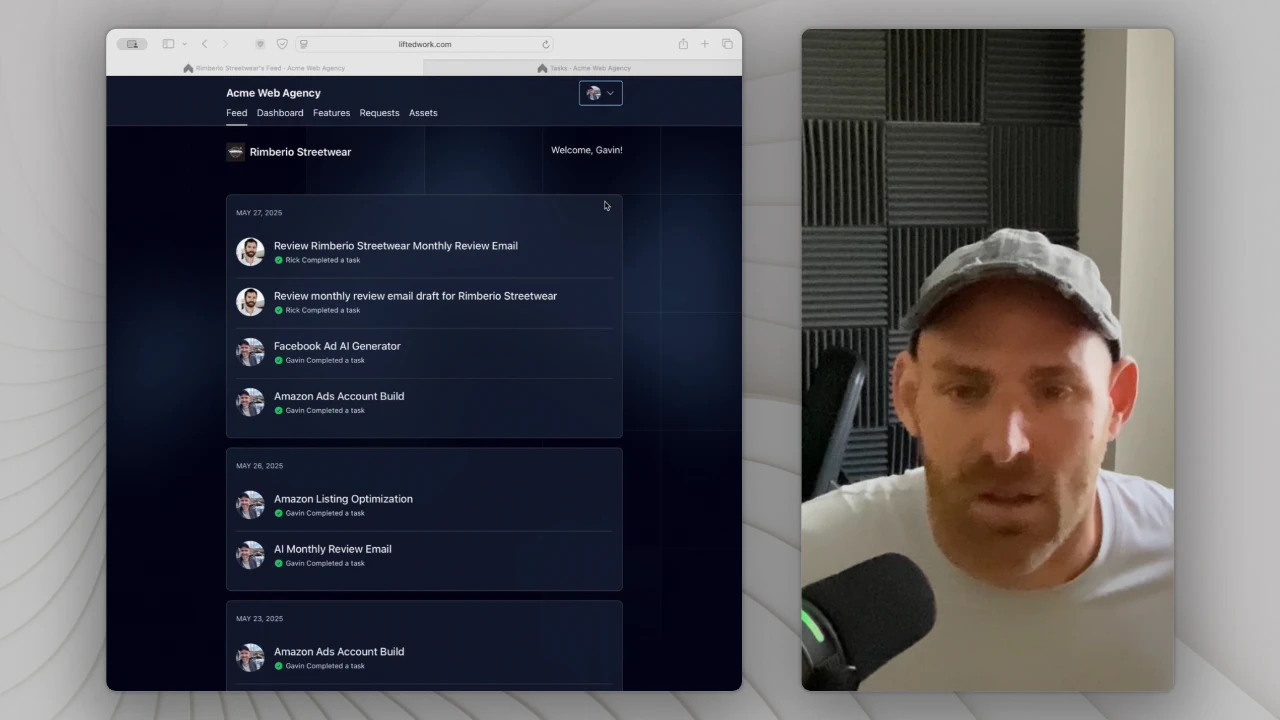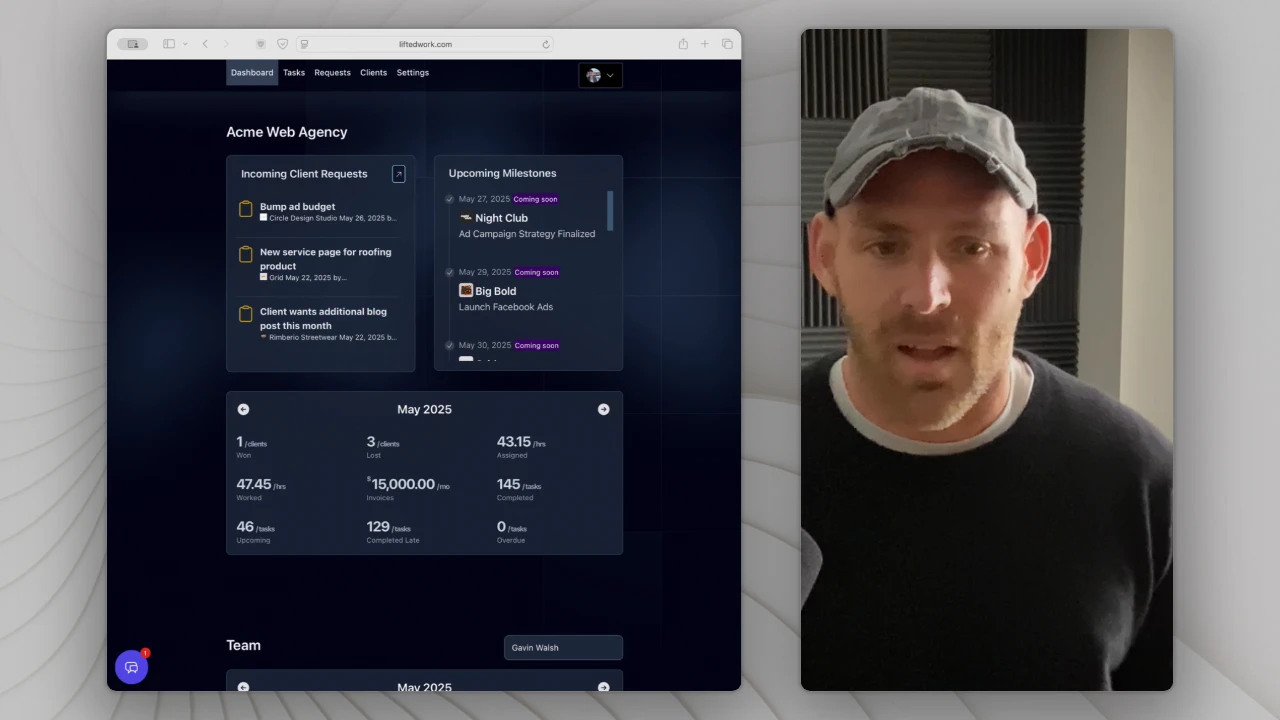Table of contents
How to Use the AI Task Scheduler in Lifted Work for Recurring and Onboarding Work
Learn how to use Lifted Work’s AI Task Scheduler to automate recurring client and internal tasks, plan monthly workloads, and streamline onboarding using smart, repeatable task templates.
Video loading...
📆 Automate Recurring Tasks and Client Workloads with AI
Recurring work is part of every agency—whether it's weekly client meetings, monthly reports, or routine internal ops. Lifted Work’s AI Task Scheduler and Autocomplete features let you set up these tasks once and let AI take care of the rest.
This guide walks you through booking recurring tasks, automating schedules, and building scalable onboarding workflows using AI.
✅ Step 1: Create the Scheduling Task
Start by creating a new task that will act as the trigger for your scheduler.
Select the client (or your internal agency “client” for non-client work)
Assign a person of record (who oversees the automation)
Set the start date for scheduling (e.g., the 1st of the upcoming month)
Toggle Autocomplete ON (if you want the task to run automatically at the scheduled time)
This task won’t be the actual work—it’s the scheduler that creates the real tasks based on your AI prompt.
🤖 Step 2: Use a Lifty Prompt to Schedule Work
In the “After Completion Prompt” field, you’ll add the Lifty AI command to create the recurring tasks.
Example prompt:
Create the following tasks:
@One Hour Meeting every Monday next month assigned to @Vivian
@Campaign Build first Friday of next month assigned to @Rick
@AI Monthly Review Email on the last day of next month assigned to @Rick
🧠 Pro Tip:
Use @ to reference saved Task Templates, Clients, and People. Templates bring in estimated time, instructions, and other preset configurations.
🕒 Why Plan Just One Month at a Time?
Recurring work can change—clients upgrade, pause, or churn. To stay flexible and avoid clutter, we recommend only booking one month at a time.
You can automate this further by adding a duplicate prompt at the end of your scheduler:
Duplicate this task for the last day of next month
This ensures your scheduler will re-create itself every month, using updated prompts.
🔁 Example: Full AI Scheduling Prompt
Create the following tasks:
@One Hour Meeting every Monday next month assigned to @Vivian
@Campaign Build on the first Friday of next month assigned to @Rick
@AI Monthly Review Email on the last day of next month assigned to @Rick
Then duplicate this task for the last day of next month.
This pattern keeps your team and clients scheduled without manual effort—month after month.
🧩 Step 3: Mark It Complete (or Let It Autocomplete)
If you toggled Autocomplete, the scheduler task will run at the exact time and date you scheduled, even if you don’t log in.
Or, you can manually mark the scheduler as complete to test your prompt before using Autocomplete.
Once triggered:
Tasks are created
Milestones (if included) are set
AI instructions are executed
Task history appears in the client’s feed
📅 Step 4: Review Upcoming Work
Head to:
Upcoming view
Filter by next month
Filter by client or person
You’ll see the full list of scheduled tasks exactly as you described in the prompt. Perfect for planning team capacity and prepping for client check-ins.
🧠 Bonus: Make Recurring Templates
If you plan to run the same scheduler each month:
Turn it into a Task Template under Settings > Task Templates
Set Autocomplete ON
Add your prompt in the after-completion field
Use relative time phrases (e.g., “every Friday next month”)
This way, anyone on your team can apply the template without rewriting prompts.
⚙️ Managing Autocomplete Filters
By default, Autocomplete tasks are hidden from normal views so they don’t clutter your workspace. If you need to find them:
Toggle the “Autocomplete” filter ON
Or search by task name in the search bar
This is especially important if you can’t find your scheduler task after it’s executed.
🧠 Onboarding Tasks vs. Recurring Work
Recurring Schedulers → Ongoing, repeatable work (meetings, reports, reviews)
Onboarding Schedulers → One-time workflows with fixed tasks and milestones (kickoff call, brand audit)
You can use Lifty to set up onboarding like:
text
CopyEdit
Create a milestone for "Kickoff Call" one business day from now Create task "Gather brand assets" due in 2 days Create task "Design homepage draft" due in 5 days
You don’t need duplication here—just build a complete one-time workflow.
🧑💼 Internal Agency Work
Need to assign recurring work to yourself or your team that isn’t client-specific?
Create a client called Your Agency
Use AI scheduling to assign internal work (e.g., reporting, marketing, admin)
Manage your business the same way you manage client accounts
🧠 Best Practices for Using Recurring AI Scheduling
✅ Book 1 month ahead
Keeps things flexible in case clients upgrade, pause, or churn.✅ Use @ mentions
Pulls in saved task templates, estimated time, and instructions automatically.✅ Use relative time phrases
Ensures the scheduler always sets dates correctly, even when reused monthly.✅ Avoid overloading the client feed
Too many small tasks can drown out important milestones and progress.✅ Duplicate schedulers monthly
Automates recurring planning without needing to reconfigure every time.✅ Test before scaling
Manually run your first AI prompt to confirm everything works before enabling Autocomplete.
✅ Recap: Automate Client and Team Scheduling
With Lifted Work’s AI Task Scheduler, you can:
Book out recurring tasks with smart prompts
Plan month-by-month to stay nimble
Assign work to team and clients automatically
Track and visualize everything across your calendar
Use Autocomplete to reduce admin work
Create templates to scale your systems
Once you’ve tested your first scheduler, copy and reuse it—and keep your agency humming without micromanaging task assignments.
Let me know if you’d like this turned into a downloadable template, onboarding doc, or embedded tooltip inside Lifted Work.

